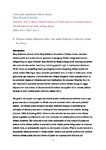National climate-mitigation policy: the spatial framing of (in)justice claims
| dc.contributor.author | Bailey, Ian | |
| dc.contributor.other | Faculty of Science & Engineering | en_US |
| dc.date.accessioned | 2019-08-09T15:29:03Z | |
| dc.date.available | 2019-08-09T15:29:03Z | |
| dc.date.issued | 2019 | |
| dc.identifier.uri | http://hdl.handle.net/10026.1/14784 | |
| dc.description.abstract |
This chapter examines how notions of justice are contested in national climate politics and the implications of competing conceptualizations of justice for progress in decarbonizing economies. The focus of investigation is the use of spatial anchors to legitimate justice arguments for or against new climate measures. Evidence from Australia, New Zealand, the US and UK indicates that advocates of stronger mitigation policy frequently emphasize broader-scale concerns about the responsibility of wealthier countries to act, while those seeking to obstruct or dilute climate initiatives often stress national welfare, (in)action by other countries, or local justice concerns. The greater skill of climate-policy opponents in constructing spatially and socially recognizable discourses about the injustices of climate action creates significant impediments to low-carbon transitions and climate justice’s influence on political agendas. To increase the impact of climate justice, the chapter advocates greater attention to representing justice arguments for climate mitigation in spatially imaginative ways. | en_US |
| dc.language.iso | en | |
| dc.publisher | University of Plymouth | en |
| dc.subject | Justice claim-making | en_US |
| dc.subject | National climate mitigation policy | en_US |
| dc.subject | Spatial framing | en_US |
| dc.subject | Spatial representation | en_US |
| dc.title | National climate-mitigation policy: the spatial framing of (in)justice claims | en_US |
| dc.type | Book | en_US |


